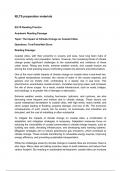IELTS preparation materials
IELTS Reading Practice
Academic Reading Passage
Topic: The Impact of Climate Change on Coastal Cities
Questions: True/False/Not Given
Reading Passage:
Coastal cities, with their proximity to oceans and seas, have long been hubs of
economic activity and population centers. However, the increasing threat of climate
change poses significant challenges to the sustainability and resilience of these
urban areas. Rising sea levels, extreme weather events, and coastal erosion are
among the most pressing issues confronting coastal city planners and policymakers.
One of the most visible impacts of climate change on coastal cities is sea-level rise.
As global temperatures increase, the volume of water in the oceans expands, and
glaciers and ice sheets melt, contributing to a steady rise in sea level. This
phenomenon exacerbates coastal erosion, inundates low-lying areas, and increases
the risk of storm surges. As a result, coastal infrastructure, such as roads, bridges,
and buildings, is at greater risk of damage or destruction.
Extreme weather events, including hurricanes, typhoons, and cyclones, are also
becoming more frequent and intense due to climate change. These storms can
cause widespread devastation to coastal cities, with high winds, heavy rainfall, and
storm surges leading to flooding, property damage, and loss of life. The economic
consequences of such events can be severe, as businesses and industries are
disrupted, and the cost of rebuilding is often substantial.
To mitigate the impacts of climate change on coastal cities, a combination of
adaptation and mitigation strategies is necessary. Adaptation measures focus on
reducing the vulnerability of coastal communities to climate change impacts, such as
building sea walls, elevating infrastructure, and developing early warning systems.
Mitigation strategies aim to reduce greenhouse gas emissions, which contribute to
climate change. These include transitioning to renewable energy sources, improving
energy efficiency, and promoting sustainable transportation.
While the challenges posed by climate change to coastal cities are immense, there is
also hope. Many cities are taking proactive steps to build resilience and reduce their
carbon footprint. By investing in sustainable development, coastal cities can increase
, their chances of withstanding the impacts of climate change and creating a more
sustainable future for their residents.
Questions:
1. Coastal cities are experiencing a decline in population due to climate change.
2. Sea-level rise is primarily caused by the expansion of ocean water.
3. Extreme weather events are becoming less frequent but more intense.
4. Building sea walls is an example of a mitigation strategy.
5. Coastal cities have no capacity to adapt to climate change.




